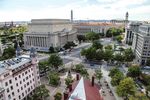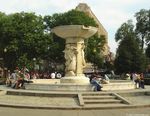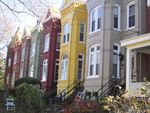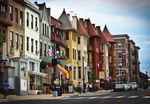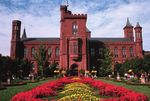Office of Fellowships and Internships - 2015 D.C. Metro Area Housing Guide
←
→
Page content transcription
If your browser does not render page correctly, please read the page content below
2
Table of Contents
Introduc on………………………………………………………………………………………………..…………….3
Washington, D.C. Housing………………………………………………………………….…………………..…4
Maryland Housing………………………………………………………………………...……….…………………8
Virginia Housing………………………………………………………………………...…………….……………….9
About Ren ng………………………………………………………………………………………….……………..10
Ge ng Around………………………………………………………………………………………..………………11
Your Housing Search……………………………………………………………………………………..…………12
Off‐Campus Housing Referral……………………………………………………………………………..……12
On‐Campus Summer Housing………………………………………………………………………………….13
The Newspapers………………………………………………………………………………………………………14
Neighborhood Abbrevia ons…………………………………………………………………………….…….15
Addi onal Tips…………………………………………………………………………….………………………….16
23
Introduc on
We hope this general informa on about the greater Washington, DC region and
its neighborhoods will be helpful as you plan your reloca on. It has ps about
ren ng and ge ng around the area, and sugges ons for housing op ons and
resources.
The following informa on has been compiled by the Office of Fellowships and In-
ternships to assist Smithsonian interns, fellows, and visi ng scholars in loca ng
housing in the greater Washington, D.C. area. This material is provided as a ser-
vice and does not cons tute an endorsement by the Smithsonian Ins tu on. The
prices quoted below are always subject to change and we advise you to call the
loca on directly to verify the informa on contained in this housing list.
34
Washington, DC
A wide variety of housing op ons are available throughout the metropolitan Washington, DC area.
Personal preference is generally the deciding factor in choosing a place to live. No ma er what
you decide, there are tradeoffs. If cost is a key issue, remember that generally the farther away
from the center of the city, the less expensive the housing. If you rely on public transporta on,
keep in mind that living outside of the city requires more travel me and is more expensive. If you
own a car, you should know that parking is generally difficult in the city, as street parking is scarce
and garages o en cost $10 per day or more. Listed below are brief descrip ons of some neighbor-
hoods in and around metropolitan Washington, D.C
Northwest (N.W.): The largest area of the District, it is composed of several contras ng neigh-
borhoods, including older areas and those being modernized and renovated. Most neighbor-
hoods within Northwest, DC are served by both Metrobuses and the Metrorail system. As neigh-
borhoods do vary within the city, visitors are well advised to visit the prospec ve home. Com-
mu ng me varies throughout this area, but generally ranges from 10-40 minutes. The follow-
ing are individual descrip ons of neighborhoods in NW DC:
Adams Morgan: This is an urban area near Dupont Circle and Kalorama, centered around Co-
lumbia Road and 18th St., NW. Adams Morgan has a diverse popula on – students, young fami-
lies, diploma c officials, recent immigrants and long me residents of the District. The neighbor-
hood is very culturally diverse with many interna onal restaurants and markets, as well as many
shops and free fes vals. Adams Morgan is also referred to as Washington Heights, Dupont Circle
North or Kalorama. Housing op ons vary enormously. Adams Morgan is an easy walk from the
Woodley Park stop on Metrorail’s Red Line or the Columbia Heights and U Street-Cardozo stop
on the Green Line.
Cleveland Park: Cleveland Park is a historic neighborhood of single-family houses and large apart-
ment buildings. The Cleveland Park Metro stop (on the Red Line) is conveniently located in an
a rac ve area of small stores, restaurants and a classic movie theater.
45
Dupont Circle: The Circle is actually the en re area around the intersec on of Connec cut and
Massachuse s Avenues, surrounded by Foggy Bo om to the south, and Kalorama and Adams
Morgan to the north. Dupont Circle is a busy office and shopping area, as well as an urban cultur-
al center. The streets and avenues that radiate from Dupont Circle offer many types of accommo-
da ons, from high-rises and smaller apartment buildings, to basement apartments or private
rooms in a home. The neighborhood is conveniently served by Metrorail’s Dupont Circle stop on
the Red Line.
Foggy Bo om: Foggy Bo om is George
Washington University’s campus and
surrounding neighborhood. Housing is
limited. Advantages to living in this area
include a close proximity to the GW
campus, The White House, The Kenne-
dy Center, Watergate Hotel, Trader Joe’s
grocery store, Pennsylvania Avenue,
museums, government agencies, and
na onal associa ons. Housing op ons
include high-rise apartments and town-
houses. Dupont Circle West and the
West End may also be considered part of the Foggy Bo om neighborhood. Metrorail’s Orange
and Blue Lines stop at Foggy Bo om.
Friendship Heights: The area located around upper Wisconsin Avenue, this neighborhood is lo-
cated on the DC/Maryland border. This area contains high-rises, bou ques, restaurants, and two
large shopping malls. Friendship Heights surrounds Wisconsin Avenue, with regular bus service
and a Metrorail sta on on the Red Line.
Georgetown: The Georgetown shopping area caters to tourists, students and young adults. Occa-
sionally townhouses are available to rent by several visitors who share the cost. Families some-
mes rent individual rooms, or basement apartments in their private homes. This area can be
reached by any bus on Pennsylvania Avenue, but is not directly served by Metrorail.
Glover Park: This neighborhood is a quiet, secluded area located just above Georgetown within
walking distance of American University and the Na onal Cathedral. The popula on of Glover
Park consists of students, young professionals and families. Group houses abound in this area,
along with smaller garden apartments. There are many restaurants and shops, and Metrobus
transporta on is available. Glover Park may also be referred to as Cathedral Heights, Observatory,
and Upper Georgetown. It is served by the Wisconsin Avenue bus, but is a good walk from the
5Logan6 Circle: The area around this Circle, north of downtown and east of Dupont Circle, consists
mainly of Victorian mansions and townhouses, many of which are currently being renovated and revi-
talized. Due to its proximity to downtown DC, this area has a mixture of accommoda ons.
Van Ness/Forest Hills: Van Ness/Forest Hills is residen al area just north of Cleveland Park. Housing
op ons range from high-rise apartment buildings to full sized houses. Close to the University of the
District of Columbia, American University, and many embassies, Van Ness/Forest hills caters to college
students, families, and diplomats alike. Van Ness/Forest Hills is on the Red Line of the Metrorail and is
also serviced by Metrobus.
Woodley Park: Woodley Park is a comfortable neighborhood of town houses and large apartment
buildings. It is north of Dupont Circle, south of Cleveland Park, and west of Adams-Morgan. Metro-
rail’s Red Line sta on at Woodley Park is in the middle of a small but a rac ve shopping area. It is al-
so the Home of the Smithsonian’s Na onal Zoological Park.
67
Northeast (N.E): This is the area around Catholic and Gallaudet Universi es and Union Sta on, a
large shopping and dining complex housing the Amtrak train terminal. Metrobuses travel regularly
through all major arteries within Northeast, and the Green and Red Lines of Metrorail service
neighborhoods of this area.
Southeast (S.E): The neighborhood most famous in this area is “Capitol Hill”, loca on of the U.S
Capitol, the Library of Congress and many other major government offices. Southeast is a very his-
toric area, consis ng of important federal buildings and residences represen ng diverse architec-
tural styles. Public transporta on via metro buses and the Metrorail system are available on a fre-
quent basis with Orange/Blue Line sta ons at Capitol South and Eastern Market.
Southwest (S.W): This is the downtown area near the Smithsonian museums on the Mall and
Washington’s waterfront. Public transporta on exists in the way of Metrobuses and the Metrorail
system with a Green Line stop at Waterfront, Blue/Orange Line stops at Smithsonian, and Blue/
Orange/Yellow/Green Line stops at L’Enfant Plaza.
78
Maryland
Bethesda, Maryland: The downtown of Bethesda is rapidly being developed and has a very urban feel-
ing. The Bethesda stop on Metro’s Red Line is centrally located on Wisconsin Avenue. There are many
large, new apartment buildings, some of which are rental. There are many restaurants in Bethesda, of
all types and price ranges.
Silver Spring, Maryland: Located on the other end of the horseshoe loop of the Red Line on Metro
from Bethesda, but not far geographically, is Silver Spring. Several large apartment buildings are con-
venient to the shopping district on Colesville Road and Georgia Avenue. Metro’s Silver Spring stop is
central to, and above it all here, where the subway is actually elevated.
Takoma Park, Maryland: Takoma Park is also on the Red Line of Metro, but rather to the east across
the border from the Northeast quadrant of DC. The Takoma Park Metro stop is near a small, low key
central shopping area.
89
Virginia
Alexandra, Virginia: Alexandria, an a rac ve historic city, offers a wide price range in the
housing and a wide variety in types of housing, although many landlords may not adver se
in newspapers. The main thoroughfare from DC to Alexandria, Shirley Highway (Memorial
and 14th St. Bridges) is very crowed during rush hour. Old Town Alexandria has a wide array
of shops, restaurants, and other a rac ons. The Yellow and Blue Lines on Metrorail make
three stops in the Alexandria area.
North Arlington, Virginia:
Arlington is an inner sub-
urb of Washington, imme-
diately across the Poto-
mac in Northern Virginia.
There are many types of
housing in North Arlington
including townhouses,
garden apartments, large
high-rises, luxury apart-
ments, duplexes, and indi-
vidual homes. North Ar-
lington is served by sever-
al stops on Metrorail’s Or-
ange Line.
South Arlington, Virginia: As in North Arlington, there are varied types of housing. Crystal
City is a sec on of high-rises off the US Route 1 overlooking the Potomac River and accessi-
ble by Metrorail on both the Blue and Yellow Lines. A new development of apartment com-
plexes has been built at Pentagon City, adjacent to the Fashion Centre shopping mall and
also accessible on both the Blue and Yellow Lines.
910
About Ren ng
The Security Deposit
If you are considering ren ng housing, you’ll need to factor in the cost of a security deposit. A
security deposit usually equals one month’s rent, which you give to your landlord in addi on to
your first month’s rent. Your security deposit is used to pay for any damages which might occur
during your occupancy, to pay for cleaning/repairs when you move out (if you don’t leave your
apartment in sa sfactory condi on), or to hold if you don’t pay your rent. Mainly, the security
deposit is an ini al expense to consider when ren ng, one you should get returned provided
you fulfill the requirements in your lease when vaca ng.
Average Rent
The following are monthly rentals of unfurnished apartments that give you an approximate idea
of what you can expect to pay. However, rents vary greatly within the metropolitan DC area.
Apartment Type Typical Rent
Efficiency $700-$2,000
1 Bedroom $1,000-$3,000
2 Bedroom $1.500-$4,500
3 Bedroom $2,000-$5,000
Allow Time for Reference Checks
Many landlords require reference checks (employer, past rentals, credit ra ng, and the like) pri-
or to your move-in, so allow me for this. Once a lease is signed, it usually means at least a
week before you can move in.
Furnishings
One solu on for furniture is to rent a furnished apartment or find space in a group house. In
addi on, Washington has an abundance of lower-priced furniture stores and you may want to
inves gate leasing furniture rather than buying.
Another alterna ve to buying new or leasing furniture is buying secondhand pieces. Be sure to
check bulle n boards at area universi es for end-of-semester furniture sales or consult news-
papers for ads on garage sales, estate closings, and
10 the like.11
Ge ng Around
Public Transporta on
Depending on where you live, you can ride Metrorail or Metrobus to get around the DC area.
Metrorail is a modern, safe and comfortable subway/commuter rail system. Metrobuses are al-
so convenient and rela vely reliable. For all Metro informa on, call 202/637-7000 from 6:00am
- 10:30pm or look at the Metro website: www.wmata.com
Metrobus stops are marked by red, white and blue signs. Look for the route number and/or
le er above the windshield of the bus. It will show you where the bus is going. Printed routes
of Metrobuses may be obtained on board the bus or at neighboring Metrorail sta ons.
There are six lines in the Metrorail system: Red, Orange, Blue, Silver, Green and Yellow. Every
Metrorail sta on is marked by a tall bronze or black column with a large “M” at the top. The
majority of Metrorail sta ons have elevators for riders with disabili es, in addi on to the usual
escalators. Inside each sta on is a color-coded map to help you plan your trip. It will also tell
you the amount of the fare and approximately how much me your trip will take. There are tra-
di onal paper fare- cards and SmarTrip Cards. A $1 surcharge is applied to each trip using a pa-
per fare-card. A SmarTrip Card is a plas c rechargeable card that costs $2 and can be encoded
with up to $300. More informa on is available at www.wmata.com/fares/smartrip. Fares are
based on when and how far you travel; the minimum one-way fare is $1.95, and fares can be as
much as $5.00 for longer distances during rush hour. A fare-card must be purchased to ride the
trains and is used to enter and exit each sta on. Be sure to obtain a transfer when changing
from Metrorail to a Metrobus. There are two fare periods for both Metrorail and Metrobus:
rush hour and non-rush hour. It costs more to ride either the Metrorail or bus during rush
hours. Rush hour mes are 5:00am to 9:30am and 3:00pm to 7:00pm, Monday through Friday.
Metro hours of opera on are currently 5:00am to midnight Monday through Thursday, 5:00am
to 3:00am Friday, 7:00am to 3:00am Saturday, and 7:00am to midnight Sunday.
Parking
Parking is limited in many areas. If a parking space/lot is not provided with an apartment, ask
about the availability of off-street parking and parking regula ons in the neighborhood. It is
generally the policy of the District of Columbia government not to issue parking permits to vehi-
cles with out-of-state license plates. Unfortunately, DC does not recognize a fellowship as equiv-
alent to student status for the purposes of applying for temporary tags.
1112
Your Housing Search
The following are some points you may wish to consider as you begin your search for tempo-
rary housing in the Washington, DC area:
How long do you want to stay in DC? What is the length of your appointment? Six weeks?
Three months? A year?
Do you plan to live with others or on your own? How are you going to find a roommate?
How much personal space do you need? Could you share a room? Do you want a dorm room,
apartment, or house?
How much can you pay for housing? Will your s pend cover all your costs? Will you use sav-
ings? Do you need access to public transporta on? Will you have a car? How will you deal with
parking? Can you walk everywhere you will need to go? Do you want on-site laundry? Can you
get to grocery stores, dry cleaners, movies, ect. easily?
Off‐Campus Housing Referral
The housing offices at the universi es listed below are good sources of informa on for off cam-
pus accommoda ons. You can check their lis ngs for housing and can obtain copies of the
Apartment Shoppers’ Guide and maps of the city. Please apply in person; no mail or telephone
inquiries are accepted.
The American University
Office of Housing & Dining Programs
Anderson Hall First Floor
4400 Massachuse s Avenue, N.W.
Washington, DC 20016-8142
George Washington University
Housing Programs
John Quincy Adams House
2129 I Street, N.W.
Washington, DC 20052
1213
On Campus Summer Housing
The following local universi es offer low coast, short term housing for visitors during the
summer months. Spaces are limited, so it is advisable to write or call as soon as possible for
an applica on for the upcoming summer.
The American University
Office of Housing & Dining Programs
Anderson Hall First Floor
4400 Massachuse s Avenue, N.W.
Washington, DC 20016-8142
Phone: 202/885-3370
Catholic University of America
Office of Housing Services
160 Father O’Connell Hall
620 Michigan Avenue, N.E.
Washington, DC 20064
Phone: 202/319-5615
George Washington University
Housing Programs
John Quincy Adams House
2129 I Street, N.W.
Washington, DC 20052
Phone: 202/994-2552
Howard University
Office of Residence Life
2401 4th Street, N.W.
Washington, DC 20059
Phone: 202/806-6131
1314
The Newspapers
The Washington Post, The Washington Times, and The City Paper all list available hous-
ing within their classified sec ons and many newspapers are available on the Internet.
The City Paper is a free weekly news and entertainment paper that has an extensive clas-
sified housing sec on. Most neighborhoods and communi es publish their own local
newspaper, such as The Uptowner and The Northwest Current. These kinds of newspa-
pers are generally free and are o en found in smaller racks of stores within each neigh-
borhood.
You can place your own “housing wanted” ad in a campus paper, or subscribe to a paper
and respond to the Summer Sublet ads. The papers will be mailed to you, so you will be
receiving them several days/weeks a er publica on. Some university papers to contact:
The American University Eagle is published on Mondays and Thursdays. You must send a
check and indicate the number of weeks you want the ad to run when you send the ad-
ver sement (202/885-1414x3)
The Georgetown Hoya comes out twice a week, Tuesday and Friday, un l May 25th
(202/687-8350).
The George Washington University Hatchet comes out twice a week, Monday and Thurs-
day (202/994-7079).
Online Resources
There are many online resources about housing in Washington, D.C. We encourage you
to do basic online searches for housing. Some good things to search for is intern housing
or searching on websites like Craigslist, Airbnb, or other real estate websites. You may
want to search for apartments, rooms, or sublets, which are be er suited searches for
short term stays.
1415
Neighborhood Abbrevia ons
When reading through the classified sec on of a newspaper, you may find some of the
loca ons difficult to understand. The following is a list of abbreviates used for some of
the neighborhoods in the metropolitan Washington, DC area:
District of Columbia Maryland
Adms Mrgn/AdMo – Adams Morgan
AU – American University AAFB – Andrews Air Force Base
Cap Hill – Capitol Hill Beth – Bethesda
Clvd Pk - Cleveland Park CH CH – Chevy Chase
Conn Ave – Connec cut Avenue Coll Pk – College Park
Dup Cir – Dupont Circle Gaith – Gaithersburg
Dwntn – Downtown
Germ – Germantown
Fog Bot – Foggy Bo om
Frndship Hgts – Friendship Heights Hya s – Hya sville
G’town – Georgetown Rockv – Rockville
Mt Plsnt – Mount Pleasant Sil Spg – Silver Spring
NE – Northeast
NW – Northwest
SE – Southeast
SW – Southwest
Wdly Pk – Woodley Park
Virginia
Alex – Alexandria
Arl – Arlington
Arl N – Arlington North
Arl S – Arlington South
Ball or Blstn – Ballston
Falls Ch – Falls Church
FFX – Fairfax
Ross or Rssln – Rosslyn
Spgfld – Springfield
1516
Addi onal Tips
* Another housing op on is the Group House, usually 4-6 people sharing a large
house and spli ng the rent and u li es. Leases are most o en month-to-month. Rent
tends to be lower than in an apartment. Houses are primarily occupied by people in their
twen es and located near university campuses. “Housing to Share” lis ngs can be found in
local papers (The Washington Post and The City Paper) and through University Off-campus
housing referrals (see above). Be sure to check the cer ficate of occupancy if more than six
unrelated persons are ren ng rooms in a group house or an en re house.
* Be aware that ren ng is a business transac on. Personal presenta on is very im-
portant, so dressing more formally is more likely to produce a favorable response in rental
agents.
* If your college/university has an alumni chapter in the Washington metropolitan
area, the office on your campus can provide you with its address or telephone number. The
local chapter can be a good source of housing informa on.
* O en landlords do not adver se vacancies in newspapers but post signs on their
proper es. The best way to find these is to walk or drive through neighborhoods where you
would like to live.
* Many Realtors are contracted with landlords to rent housing. Consult the ads under
the real estate heading in the Yellow Pages of a phone director to find realtors that handle
rentals.
* Verbal rental agreements are binding and legally enforceable, but it is safer to have
a wri en agreement in order to avoid misunderstanding the terms and condi ons. Be sure
to retain a copy signed by the landlord’s agent in order to protect yourself in the event of a
dispute. Most landlords will have lease or rental forms. DC rental agreements or leases
made by persons under 18 must be signed by a parent or guardian. Rental agreements or
leases made by persons under 18 can be and generally are binding in Maryland and Virgin-
ia, but landlords may require a parent’s or other co-signature.
*When inves ga ng prospec ve housing op ons, look for security in and near the
building (i.e., locked doors, access of laundry room to outsiders, well lit hallways and laun-
dry rooms, grilled windows on ground floors (a must for basement apartments) and well lit
streets nearby).
Please feel free to contact the Office of Fellowships and Internships at 202/633‐7070 or
siofi@si.edu if you have any ques ons.
16You can also read

